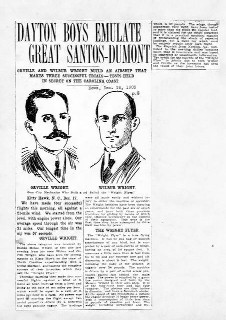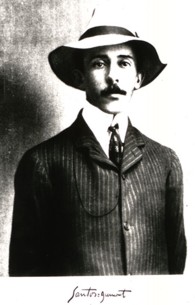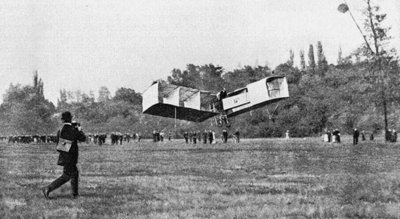Alberto Santos-Dumont
|
|
Alberto Santos-Dumont (July 20, 1873 - July 23, 1932) was a Brazilian aviation pioneer. He designed, built, and flew many balloons as well as the first practical dirigible. In addition, He made the first public flight of an airplane in Paris in October of 1906. That aircraft, designated 14 Bis, was the first to take off, fly, and land without the use of catapults, high winds, or other external assistance.
| Contents |
Childhood in Brazil
Santos-Dumont was born in the Brazilian state of Minas Gerais, the youngest of 11 children. He grew up in a coffee plantation owned by his family in the state of São Paulo. His father was an engineer, and made extensive use of the latest labor-saving inventions in his vast property. So successful were these innovations that Santos-Dumont's father gathered a large fortune and became known as the "Coffee King of Brazil."
Santos-Dumont was fascinated by machinery, and while still a young child he learned to drive the steam tractors and locomotive used on his family's plantation. He was also a fan of Jules Verne and had read all his books before his tenth birthday. He wrote in his autobiography that the dream of flying came to him while contemplating the magnificent skies of Brazil in the long, sunny afternoons at the plantation.
Move to France
In 1891, Alberto's father had an accident while inspecting some machinery. He fell from his horse and became a paraplegic. He decided then to sell the plantation and move to Europe with his wife and his youngest son. At seventeen, Santos-Dumont left the prestigious School of Mines in Ouro Preto, Minas Gerais, for the city Paris in France. The first thing he did there was to buy an automobile. Later, he pursued studies in physics, chemistry, mechanics, and electricity, with the help of a private tutor.
Balloons and dirigibles
Missing image
14-bis-wth-air-ballon-aid.jpg
Santos-Dumont hired an experienced balloon pilot and took his first balloon rides as a passenger. Eventually he piloted them himself, and soon was designing his own balloons. In 1898, Santos-Dumont went up in his first balloon design, the Brésil. After numerous balloon flights, he turned to the design of steerable balloons or dirigible type balloons that could be propelled through the air rather than drifting along with the breeze. (See Airship)
Between 1898 and 1905 he built and flew 11 dirigibles. The zenith of his lighter-than-air career came on October 19, 1901 when he won the Deutsch de la Meurthe prize of 100,000 francs for flying his dirigible Number 6 from the Parc Saint Cloud to the Eiffel Tower and back under thirty minutes. In a charitable gesture, he donated half of the prize money to the poor of Paris. The other half was given to his workmen as a bonus.
Alberto's aviation feats made him a celebrity in Europe and throughout the world. He won several more prizes and became a friend to millionaires and royalty. In 1901 he was considered by many to be the most famous person in the world. In 1904, he went to the United States and was invited to the White House to meet US President Theodore Roosevelt.
Heavier than air
Although Santos-Dumont continued to work on dirigibles, his primary interest soon turned to heavier-than-air-craft. By 1905 he had finished his first airplane design, and also a helicopter. He finally achieved his dream of flying on an airplane in October 23 of 1906, when, piloting the 14 Bis before a large crowd of witnesses, he flew a distance of 60 metres (197 ft) at a height of 2-3 m. This well-documented event was the first flight verified by the Aero-Club De France of a powered heavier-than-air machine in Europe, and the first public demonstration in the world of an aircraft taking off from an ordinary airstrip with a non-detachable landing gear and on its own power (self-propelled) and in calm weather, officially resolving the problem of getting a machine that is "heavier than air" to take off the ground by its own means. With this accomplishment, he won the Archdeacon Prize founded by the Frenchman Ernest Archdeacon in July of 1906, to be awarded to the first aviator to fly more than 25 meters. On November 12 of the same year, Santos-Dumont succeeded in setting the first world record in aviation by flying 220 meters in less than 22 seconds. Both of these events occurred before the Wright Brothers had made any public flights (See "Disputed title" section below for more details.)
Santos-Dumont made numerous contributions to the field of aircraft control. The most noteworthy one was the use of effective ailerons at the tips of the wings. He also pushed for and exploited substantial improvements in engine power- to-weight ratio, and other refinements in aircraft construction techniques.
Disputed title
The claim to the first flying machine is still the ground disputes about definitions, facts, priorities, and merits. These polemics are often fueled by strong nationalistic or cultural feelings.
In some countries today, particularly Brazil, Santos Dumont is considered to be the "Father of Aviation", because of the official and of public character of the 14-bis flight and/or technical points such as the plane's integral landing gear and its ability to take off on open ground. This has been traditionally the official position of the Brazilian government, especially since the Getúlio Vargas dictatorship. Some admirers of Santos-Dumont go further and question the official history of other early flyers, such as the early Wright brother's earlier flights, claiming, for instance, that those exploits still have not been convincingly replicated with modern reconstructions of the Wright Flyers, that documents are inconclusive or unreliable, that witness reports are inconsistent, or even that some photos were forged [1] (http://www.thefirsttofly.hpg.ig.com.br/pioneer2.htm). A number of other early flying machines with less esteem are also, often disregarded as well.
There were many machines that got up into the air in a limited fashion and many variations of heavier-then-air titles to which varying amounts of credit have been awarded by various groups. For example, in the former USSR Aleksandr Fyodorovich Mozhaiski is sometimes credited as a "Father of Aviation", for his powered heavier-then-air machine going airborne (generally recognized as the second such flight in that category) in 1884.[[2] (http://www.flyingmachines.org/moz.html)] The disputes about the proper definition of "powered heavier than air flight" still go on. For example, with regard to gliders fitted with small engines that are used non-continuously; these debates do not extend to methods of take off systems. The issue of assisted takeoff can be a issue with early flights, however, since any help given is more significant for how long they were airborne for short flights.

Headline from page 8 of
the December 18, 1903 edition of
The Dayton Daily News.
From the archives of the Dayton Metro Library[3] (http://home.dayton.lib.oh.us/archives/wbcollection/wbscrapbooks1/WBScrapbooks10004a.html)
Article refers to Wright's flight's without
the "gas bag" assistance of Dumonts earlier Airships.
Much of the controversy with regard to Santos Dumont vs. the Wrights arose from the difference in their approaches to publicity. Santos made his flights in public, often accompanied by a great deal of fanfare. In contrast, the Wrights were very concerned about protecting their intellectual property and made their early flights in remote locations and without recongnized officials present. In November 1905, the Aero Club of France learned of the Wrights' alleged flight of 24 miles. They send their correspondent to investigate the Wright’s accounts, which are verbally confirmed by him but without the production of any hard evidence. In January 1906 people in the Aero Club of France's meeting are stunned by the unproven reports of the Wright’s flights. Archdeacon sends a taunting letter to the Wrights, demanding that they come to France and prove themselves. The Wrights do not respond. Thus, the aviation world (of which Paris was the center at the time) witnessed the products of Santos' work first hand. As a result, many members of the scientific community as well as the public dismissed the Wrights as frauds (There were many aviation frauds being perpetrated at the time.) and held Santos Dumont as the "first to fly."
In some other countries today, particularly the US, while there remains a high regard for Santos Dumont's accomplishments, and a recognition of the 14-bis flight as a important event in early aviation, the honor of first effective heavier-than-air flight is most commonly assigned to the Wright brothers for their flight of 39 meters (120 feet) in 12 seconds on December 17, 1903 at Kitty Hawk in the US.
In any case, early reports of the Wrights' activities and the disclosure of key design features in their 1904 European patent filings certainly helped many airplane developers in succeeding years, including Santos Dumont. Moreover, Santos Dumont's success was aided by improvements in engine power/weight ratio and other advances in materials and construction techniques that had taken place in previous years.
Just as some seek to broaden the accomplishments of the 14-bis flights, there are others who seek to narrow them, although this is less common. One criticism is that the low altitude at which the 14-bis flew permitted the lift to be augmented by ground effect. If so, then the argument is sometimes made that the craft was not a true heavier-then-air-craft flight. The often low flights of many aviation pioneers, including some of the Wrights initial flights, fall prey to a complex debate over classifications of machines that are aided by this phenomenon.
Also, there have been some questions of the Aero-Club De France's conflict of interest concerning their involvement with Dumont's claim. The questions largely arise from their knowledge of the Wrights, members being in competition with them, and their involvement with Dumont. How partial the Aero-Club De France was to Santos-Dumont is a matter of debate.
Santos-Dumont and the wristwatch
The wrist watch had already been invented by Patek Philippe, decades earlier, but Santos-Dumont played a important role popularizing its use by men in the early 1900s. Before him they were generally worn only by women, as men favored pocket watches. As a result, especially in Brazil, Santos-Dumont is considered by some to be the inspiration for the modern Wristwatch.
The story goes that in 1904, while celebrating his winning of the Deutsch Prize at Maxim's Restaurant, Alberto complained to his friend Louis Cartier about the difficulty of checking his pocket watch to time his performance during flight. Alberto then asked Cartier to come up with an alternative that would allow him to keep both hands on the controls. Cartier went to work on the problem and the result was a watch with a leather band and a small buckle, to be worn on the wrist.
Santos-Dumont never took off again without his personal Cartier wristwatch, and he used it to check his personal record for a 220 m (722 ft) flight, achieved in twenty-one seconds, on November 12, 1907. The Santos-Dumont watch was officially displayed on October 20, 1979 at the Paris Air Museum next to the 1908 Demoiselle, the last aircraft that he built.
Back to Brazil
Santos-Dumont continued to build and fly airplanes until he fell ill in 1910 with what was postumously diagnosed as multiple sclerosis. He abruptly dismissed his staff and shut down his work shop. His illness soon led to depression. He moved from Paris to the French seaside and took up astronomy as a hobby. Some of the local folk, who knew little of his great fame and exploits in Paris just a few years earlier, mistook his telescopes and unusual accent as signs (almost certainly false) that he was a German spy who was tracking French naval activity. These suspicions eventually led to Santos having his rooms searched by the local constabulary. Upset by ignamony of the charge, as well as depressed from his illness, he burned all of his papers, plans, and notes. Thus, there is little direct information available about his designs today.
In 1928 (some sources report, 1916) he left France to go back to his country of birth, never to return to Europe. His return to Brazil was marred by tragedy. A dozen members of the Brazilian scientific community boarded a seaplane with the intention of paying a flying welcome to the returning aviator on Cap Arcona. Instead, the seaplane crashed with the loss of all on board. The loss deepened Santos' growing despondency.
In Brazil, Santos bought a small lot on the side of a hill in the city of Petrópolis, in the mountains near Rio de Janeiro, and built there a small house filled with imaginative mechanical gadgetry.
Death and beyond
Alberto Santos-Dumont — seriously ill, and said to be depressed over his multiple sclerosis and the use of aircraft in warfare — is believed to have committed suicide by hanging himself in the city of Guarujá in São Paulo, on July 23, 1932. He was buried in the Cemitério São João Batista in Rio de Janeiro.
Having never married, and having left no known children, his contributions to aviation remain his only legacy.
Media
Template:Multi-video start Template:Multi-video item Template:Multi-video end


